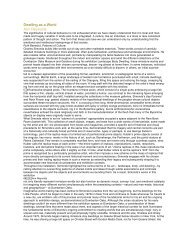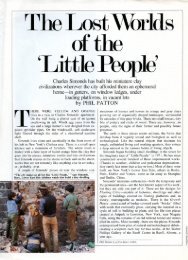Read Catalog - Charles Simonds
Read Catalog - Charles Simonds
Read Catalog - Charles Simonds
Create successful ePaper yourself
Turn your PDF publications into a flip-book with our unique Google optimized e-Paper software.
<strong>Simonds</strong>'s manifest preference for the direct contact with the public afforded<br />
by working in the street does not, then, preclude an interest in engaging the<br />
art audience. Indeed, his involvement with the latter goes beyond museum<br />
works. Almost since the initial appearance of the Little People, <strong>Simonds</strong> has<br />
been making pieces for private collections. Many of these are executed on the<br />
spot, the first under a piano in a New York apartment in 1971, and one of the<br />
most recent in the stairwell of a house in Belgium. <strong>Simonds</strong> is motivated to<br />
make these pieces in some cases out of affection for the recipients, in others<br />
because of an interest in the possibilities of the particular physical situation.<br />
The Belgian family gave <strong>Simonds</strong> the liberty of removing part of a wall beside<br />
the stairs, permanently altering the interior of their home.<br />
If, finally, the dichotomy in <strong>Simonds</strong>'s work between public and private, outdoor<br />
and indoor, destructible and collectible pieces seems irreconcilable, so<br />
much the better. It is refreshing to encounter an artist who embraces ambiguity,<br />
who, in aspiring to a wider audience, is not at all anxious about appearing<br />
inconsistent. The many forms assumed by <strong>Simonds</strong>'s art and the<br />
many situations in which it is made, represent his best efforts to address the<br />
broadest possible public in the situations and the vocabulary most appropriate<br />
to them. Yet within the work there is a unifying logic that withstands these<br />
variations in form and audience. It is a logic based on <strong>Simonds</strong>'s beliefs in<br />
the identity between the landscape, the body, and architecture, and in the<br />
relationships between where we are and how we live. These convictions help<br />
reconcile the works with their settings, reducing the figure-ground duality,<br />
and bring <strong>Simonds</strong> into closer contact with his audience. Compelled by his<br />
instincts as a cultural geographer, <strong>Simonds</strong> applies these ideas to every situation<br />
in which he finds himself. The result is an art of ostensible whimsy and<br />
ultimate gravity.<br />
Footnotes<br />
I<br />
For the artist's description of the genesis of this work, see "The Spiral Jetty," in The<br />
Writings of Robert Smithson, Nancy Holt, ed., New York: New York University Press,<br />
I9791 pp. I09·II6.<br />
2<br />
Quoted in Bib. I 1978, <strong>Simonds</strong> and Molderings, p. 20.<br />
3<br />
Ibid., p. 2r.<br />
30












